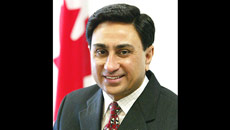Fabian Dawson is a 2019 recipient of the Bruce Hutchison Lifetime Achievement Award

1. You are the first Asian-Canadian to be awarded the Jack Webster Foundation’s 2019 Bruce Hutchison Lifetime Achievement Award. What does this honour mean to you?
I am honoured to receive this award. It is a special privilege for me to be the first Canadian of Asian descent to get it. I hope it will serve to further illustrate the immigrant experience and as an inspiration for New Canadians in journalism.
2. What is the Bruce Hutchison Lifetime Achievement Award and who is it usually given to?
The Jack Webster Foundation's Bruce Hutchison Lifetime Achievement Award honours an exemplary BC journalism career. It recognizes the careers of senior reporters and editors who have received distinction in their communities for work of long-lasting significance, clarity, fairness and innovation. Recipients of this award are chosen by the Jack Webster Foundation Board of Directors. The outstanding career of Bruce Hutchison from 1918 to 1992, is a primary guide in reviewing potential candidates for the award.

3. Can you talk about your most memorable work till date as a journalist?
While there have been many, I would say the work we did on exposing the social scourge of abandoned brides, who have become victims of cultural fraud in India would fit this bill. Our comprehensive work in Canada and India that led to international coverage and accolades has led to changes in the law that is beginning to see some impact.
4. Your reporting on the murder of Jaswinder (Jassi) Sidhu has been greatly followed. What are your thoughts on the result your coverage has led to?
I never met this young woman who was so full of love and murdered because of it. But today, after 10 trips to India, scores of interviews, three documentaries, a made-for-TV movie, a website called justiceforjassi.com and the book Justice for Jassi, I know her very well. I have pursued this story for over 18 years and I hope one day soon there will be Justice for Jassi.

5. What projects are you working on at the moment?
One of the bigger projects now is a potential Netflix series on the Jassi murder case and my other work in India including dowry-related contract killings and the plight of abandoned brides. I also continue to consult with international companies on media issues.
6. How would you compare present journalism and media industry as compared to your past experience?
This is one industry that has seen tremendous changes over the last generation. When I started your principal tools were a notebook and pen and you were always on the lookout for a public pay phone to send stories from the scene of reporting to beat deadlines. Today’s journalist is expected to be a reporter, photographer, and videographer, as well as an editor and producer of stories…they have to be masters of technology as well as skillful story tellers who must continually update and repurpose their content for platform agnostic delivery on social media, broadcast and print.

7. Is there anything that today’s media industry lacks?
Two things come to mind here, one is isolation and the other is leadership. Without brick and mortar newsroom settings where journalists can bounce ideas and rub off each other constantly, many tend to work remotely and alone. This has led to fewer investigative features where teams work together. I am a big believer that an editor is as good as his or her reporter and vice-versa. Many a time newsroom conflicts arise from editors not knowing what it takes to get, do and deliver story packages, because they have not done it themselves. In many cases, senior editors in larger operations are not digital natives and do not have experience in what we refer to as backpack journalism. In other cases, newer online news portals tend to have managers who are primarily digital natives and who are more interested in likes or shares on social media channels rather than the depth of the content.
8. It is unfortunate that the rise of online media has led to print media going down. As a long-time journalist, do you ever feel that print media will make a comeback in the future?
When TV arrived, they said it is the death of radio. When the internet took hold, they said it was the death of the newspaper. But there is a resurgence in print now as people want to cut through the digital noise and constant flow of ads and information. The resurgence of print will also appeal to people who increasingly want a tactility…to hold and feel what they are reading…I believe there will be a comeback especially in niche publications. Traditional newspapers and magazines created online editions to increase their reach…Now many online-only media operations are printing weekly or monthly editions to enhance their credibility quotient and show not everyone should be a publisher.

9. There are more and more South Asians in the media industry today, what do you have to say about this growing change and representation?
This is a good thing and not just only for South Asians but for all minority groups. The increasing presence of South Asian personalities in mainstream media helps influence the public image of minorities. It helps dispel stereotyping and promotes views which are not adequately reflected in public discourse. Immigration is a defining feature of Canada and new Canadians, mostly from Asia currently represent one in five people in Canada. My hope is one day that statistic is reflected in our newsroom diversity counts
10. Your work has inspired many South Asians interested in the field of journalism, what is your advice to youngsters interested in a career in journalism?
Journalism is not about colour. It’s about courage. It’s not about where you come from, it’s where you are going. Use your ethnicity for context not conflict. Ultimately good journalism is not just about reflecting what is going on around you, it’s about using journalism as a vehicle for social change.



